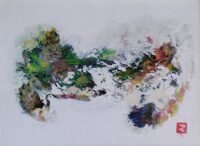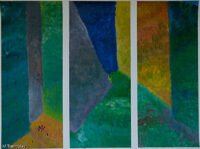Wittgenstein: “Whereof one cannot speak, thereof one must be silent.” (Tractatus 7)
These works are about how when we look at abstract paintings, we often lack words as we don’t immediately grasp the meaning of the painting. This is not surprising as it takes about 15 seconds for our brain to discern that what we are looking at is important, at which point, it starts to process in detail the image.
That often means that after awhile, the painting starts to speak to us, as our brain starts to make associations with memories and our mind starts to create new meaning.
Paintings of this sort try to capture the ineffable, that which isn’t but actually is, we just don’t know how. But a painting can help us visualise that for which we lack words. We often use the word ‘thing’ when we are actually at a loss for the name of something, or a similar word for person whose name we’ve forgotten. In some ways, things like this are on the way to being named, and hence tamed by our own personal sense of order.
When we look at abstract art, our brain kicks into gear to try to make sense of the images, creating associations real sense, but we lack ways of articulating that ‘thing’. We are silent as we endeavour to decode, make sense of, or place in our reality, some’thing’ that isn’t yet named.

























































